STEP Joists™
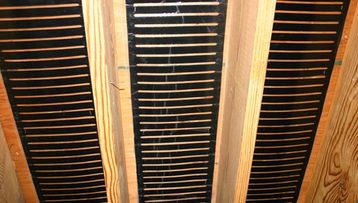
STEP Joists™ under floor radiant heating element is designed to provide radiant heat to existing floors by accessing the floor joists from below. This element can be ordered without slots and can be stapled or nailed through for easy installation.
The retrofit solution can be used as primary or supplementary heating and can be installed to heat under most floor coverings, including tile, stone, wood, laminate and carpet. For total heating a heat loss calculation is required.
After stapling the radiant heating elements between the floor joists and making the electrical connections, insulation is installed underneath the heating element. The insulation enhances the energy efficiency by minimizing heat loss and directing the warmth upwards through the floor.
STEP Joists™ is also available in 9" (22,9cm) width.
The retrofit solution can be used as primary or supplementary heating and can be installed to heat under most floor coverings, including tile, stone, wood, laminate and carpet. For total heating a heat loss calculation is required.
After stapling the radiant heating elements between the floor joists and making the electrical connections, insulation is installed underneath the heating element. The insulation enhances the energy efficiency by minimizing heat loss and directing the warmth upwards through the floor.
STEP Joists™ is also available in 9" (22,9cm) width.
Features of STEP Joists™
- Strong, thin and flexible element
- Designed to provide even and comfortable warmth in a home. A heat loss calculation is required when primary heating is expected
- Install elements below existing floor between the joists without tearing up existing floor
- Elements can be stapled and nailed through for easy installation
- Operates on 24 volts (AC/DC); Connect to a power supply, solar or wind power
- Compatible with any floor covering including, tile, stone, wood, laminate, resilient and carpet.
- Self-regulating; As the material gets warmer, less electricity passes through the plastic – therefore it is extremely energy-efficient
- Easy to install; cut elements to size on the job site, staple or nail elements underneath existing floor between the joists, connect wires to power supply and elements and install proper installation underneath
- Maintenance-free when installed and does not require a utility room or dangerous storage of fuel or gas
Product Specifications
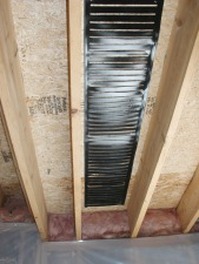
Heating Element Model:
EP-30-2-29W-24V
Output Wattage (at 24 Vac):
9 W/ft (29 W/m) @ 68ºF (20ºC)8.4 W/ft (27 W/m) @ 86ºF (30ºC)
Nominal Resistance:
64 Ω/ft (20 Ω/m) @ 68ºF (20ºC)
Width: 12" (30,5 cm)
Length: Cut to Order
Thickness: 3/64" (1,2 mm)
EP-30-2-29W-24V
Output Wattage (at 24 Vac):
9 W/ft (29 W/m) @ 68ºF (20ºC)8.4 W/ft (27 W/m) @ 86ºF (30ºC)
Nominal Resistance:
64 Ω/ft (20 Ω/m) @ 68ºF (20ºC)
Width: 12" (30,5 cm)
Length: Cut to Order
Thickness: 3/64" (1,2 mm)
SYSTEM COMPONENTS
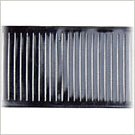
HEATING ELEMENT (EP-30-2-29W-24V)
Low voltage (24V, AC or DC), self-regulating Positive Temperature Coefficient (PTC) semi-conductive polyethylene. Patented. Cut to order with 174 feet maximum shipping spool length.
Low voltage (24V, AC or DC), self-regulating Positive Temperature Coefficient (PTC) semi-conductive polyethylene. Patented. Cut to order with 174 feet maximum shipping spool length.
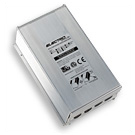
EPI-LX POWER SUPPLY (EPI-LX-500, EPI-LX-1000, EPI-LX-1500)
Low voltage, dry type isolation power supply. 120 / 208 / 230 Vac primary and 24 Vac secondary. Extruded aluminum profile enclosure w/ heat sink. Primary and secondary circuit protection. RoHS compliant interface board. For indoor use only. Patent pending.
Low voltage, dry type isolation power supply. 120 / 208 / 230 Vac primary and 24 Vac secondary. Extruded aluminum profile enclosure w/ heat sink. Primary and secondary circuit protection. RoHS compliant interface board. For indoor use only. Patent pending.
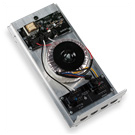
EPI-LX-R POWER SUPPLY (EPI-LX-R-500, EPI-LX-R-1000, EPI-LX-R-1500)
Low voltage, dry type isolation power supply with regulator. 120 / 208 / 230 Vac primary and 24 Vac secondary. Extruded aluminum profile enclosure w/ heat sink. Primary and secondary circuit protection. RoHS compliant interface & regulator board. For indoor use only. Patent pending.
Low voltage, dry type isolation power supply with regulator. 120 / 208 / 230 Vac primary and 24 Vac secondary. Extruded aluminum profile enclosure w/ heat sink. Primary and secondary circuit protection. RoHS compliant interface & regulator board. For indoor use only. Patent pending.
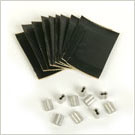
CONNECTOR & TAPE KIT (C&T-10)
Includes (10) CON-DB Crimp Connectors, (1) 15” long piece of TAPE-1 Sealant Tape, (1) Label-1, (1) Label-2, and an installation brochure. Contains material to connect and seal five heating element strips to extension wires.
Includes (10) CON-DB Crimp Connectors, (1) 15” long piece of TAPE-1 Sealant Tape, (1) Label-1, (1) Label-2, and an installation brochure. Contains material to connect and seal five heating element strips to extension wires.
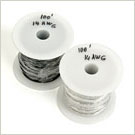
EXTENSION WIRE (TCu14-XXX-B/-W, TCu12-XXX-B/-W)
#14 (or #12) AWG stranded tinned copper (TCu) PVC insulated wire, 300 Vac, 105°C. Used to extend heating element bus braid wires to TB-4X5A Terminal Board.
Color Code: -B indicates black; -W indicates white
Spool Length: XXX = 50, 100, 150, 250 or 500 feet
#14 (or #12) AWG stranded tinned copper (TCu) PVC insulated wire, 300 Vac, 105°C. Used to extend heating element bus braid wires to TB-4X5A Terminal Board.
Color Code: -B indicates black; -W indicates white
Spool Length: XXX = 50, 100, 150, 250 or 500 feet
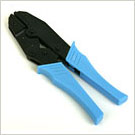
CRIMP TOOL (TOOL-PRO)
Used to crimp CON-DB crimp connector. TOOL-PRO crimp tool is required as it is specially designed to properly crimp CON-DB crimp connector.
Used to crimp CON-DB crimp connector. TOOL-PRO crimp tool is required as it is specially designed to properly crimp CON-DB crimp connector.
OPTIONAL COMPONENTS
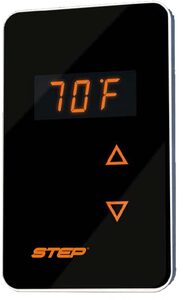
STEP Touch® THERMOSTAT
Benefits:
The STEP Touch® Thermostat saves energy and allows you to maintain the radiant floor heating system to the desired temperature level.
STEP Warmfloor® is self-regulating and cannot overheat; therefore it is as if you had a sensor over the whole floor surface. Although the heating system does not require a control unit, you may want to install a thermostat and external sensor for the following reasons:
STEP Touch® Thermostat can be used in conjunction with the regulator on the STEP® Power Supply, with the STEP® AC Controller or with the STEP® DC Controller.
Advantages:
The STEP Touch® thermostat is not an on/off control device typical of thermostats used with conventional heating systems. The STEP Touch® thermostat is designed to pulse the power supply (EPI-LX-R) which in turn powers the STEP Warmfloor® self-regulating heating elements closely matching the heat output according to heating needs for a zone and to prevent excess temperature typical of other heating systems. These pulses ensure a maximum level of efficiency and personal comfort.
The high energy efficiencies achieved with a STEP Warmfloor system controlled by a STEP Touch® thermostat are due to the continuous pulsing operation of the system (every 1.5 seconds). These continuous pulses allow the system to continuously add the right amount of heat to maintain a constant and comfortable environment. With a traditional forced air on/off controlled heat system, the system is on and off for long durations requiring significant heat input each time the thermostat calls for heat. This result in a variable and drafty environment with low energy efficiencies compared to radiant heat. The STEP Touch thermostat maximizes the efficiency of the STEP Warmfloor® system by only requiring the system to gently replace the heat that is lost from the zone.
Understanding Programmable Thermostats:
Consumers are often advised that installing a programmable thermostat can save them anywhere from 10 to 30% on the space heating and cooling portion of their energy bills. While reliant on proper use of the programmable thermostat, such savings are easily true in theory; however, there needs to be more field-tested data to better substantiate savings claims. Analyses from recent field studies have suggested that programmable thermostats may be achieving considerably lower savings than their estimated potential.
Why is there a discrepancy between the theoretical and actual savings with programmable thermostats? Because the proposed savings were, in actuality, theoretical. That is, they were based on computer models and not on real-world experience. Now that there’s enough real-world data, it’s clear that programmable thermostats have only a minimal impact on energy consumption. As in other areas of personal finance, it’s human behavior that makes the most difference.
Programmable thermostats can reduce energy consumption — if they’re used right, under ideal conditions. But so can regular thermostats. What does make a difference on your heating and cooling costs? According to a Wisconsin study, your attitude toward conservation makes a big difference in energy consumption.
In 2009, The EPA (US Environmental Protection Agency) suspended Energy Star certifıcation for programmable thermostats, writing:
“EPA has been unable to confirm any improvement in terms of the savings delivered by programmable thermostats and has no credible basis for continuing to extend the current Energy Star specification.”
The ENERGY STAR specification for programmable thermostats was suspended on December 31, 2009 and the Energy Star label is no longer available for this category. Manufacturers were required to cease using the Energy Star name and mark in association with all products manufactured on or after December 31, 2009.
Benefits:
The STEP Touch® Thermostat saves energy and allows you to maintain the radiant floor heating system to the desired temperature level.
STEP Warmfloor® is self-regulating and cannot overheat; therefore it is as if you had a sensor over the whole floor surface. Although the heating system does not require a control unit, you may want to install a thermostat and external sensor for the following reasons:
- Not everyone has the same temperature comfort needs
- You may want to keep some rooms warmer than others
- You want to keep the floors warm and not rely on the ambient temperature
- When the house is not in use you may not need much heat, but you do not want to risk the water tubing to freeze
- You are aware of energy efficiency and want to keep the cost down
STEP Touch® Thermostat can be used in conjunction with the regulator on the STEP® Power Supply, with the STEP® AC Controller or with the STEP® DC Controller.
Advantages:
The STEP Touch® thermostat is not an on/off control device typical of thermostats used with conventional heating systems. The STEP Touch® thermostat is designed to pulse the power supply (EPI-LX-R) which in turn powers the STEP Warmfloor® self-regulating heating elements closely matching the heat output according to heating needs for a zone and to prevent excess temperature typical of other heating systems. These pulses ensure a maximum level of efficiency and personal comfort.
The high energy efficiencies achieved with a STEP Warmfloor system controlled by a STEP Touch® thermostat are due to the continuous pulsing operation of the system (every 1.5 seconds). These continuous pulses allow the system to continuously add the right amount of heat to maintain a constant and comfortable environment. With a traditional forced air on/off controlled heat system, the system is on and off for long durations requiring significant heat input each time the thermostat calls for heat. This result in a variable and drafty environment with low energy efficiencies compared to radiant heat. The STEP Touch thermostat maximizes the efficiency of the STEP Warmfloor® system by only requiring the system to gently replace the heat that is lost from the zone.
Understanding Programmable Thermostats:
Consumers are often advised that installing a programmable thermostat can save them anywhere from 10 to 30% on the space heating and cooling portion of their energy bills. While reliant on proper use of the programmable thermostat, such savings are easily true in theory; however, there needs to be more field-tested data to better substantiate savings claims. Analyses from recent field studies have suggested that programmable thermostats may be achieving considerably lower savings than their estimated potential.
Why is there a discrepancy between the theoretical and actual savings with programmable thermostats? Because the proposed savings were, in actuality, theoretical. That is, they were based on computer models and not on real-world experience. Now that there’s enough real-world data, it’s clear that programmable thermostats have only a minimal impact on energy consumption. As in other areas of personal finance, it’s human behavior that makes the most difference.
Programmable thermostats can reduce energy consumption — if they’re used right, under ideal conditions. But so can regular thermostats. What does make a difference on your heating and cooling costs? According to a Wisconsin study, your attitude toward conservation makes a big difference in energy consumption.
In 2009, The EPA (US Environmental Protection Agency) suspended Energy Star certifıcation for programmable thermostats, writing:
“EPA has been unable to confirm any improvement in terms of the savings delivered by programmable thermostats and has no credible basis for continuing to extend the current Energy Star specification.”
The ENERGY STAR specification for programmable thermostats was suspended on December 31, 2009 and the Energy Star label is no longer available for this category. Manufacturers were required to cease using the Energy Star name and mark in association with all products manufactured on or after December 31, 2009.
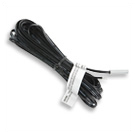
FLOOR SENSOR (EPI-LX-SEN)
Floor temperature sensor. Required when using F mode & AF mode on EPI-LX-TH & EPI-LX-THPR thermostats – not required for A mode. Leads are 15 feet in length.
Floor temperature sensor. Required when using F mode & AF mode on EPI-LX-TH & EPI-LX-THPR thermostats – not required for A mode. Leads are 15 feet in length.
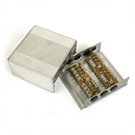
TERMINAL BLOCK (T-BLOCK) WITH ENCLOSURE
Two-pole, power terminal block enclosed in extruded aluminum profile w/ heat sink. Set screw lug terminals sized for #14-#4 AWG wires, terminal assignments – one HOT bar and one NEUTRAL bar. Both bars have four lugs.
Two-pole, power terminal block enclosed in extruded aluminum profile w/ heat sink. Set screw lug terminals sized for #14-#4 AWG wires, terminal assignments – one HOT bar and one NEUTRAL bar. Both bars have four lugs.
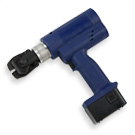
POWERED CRIMP TOOL (KWIR)
Used to crimp CON-DB crimp connector. KWIR powered crimp tool is cordless and is specially designed to properly crimp CON-DB crimp connector. Operates on 12V rechargeable battery. Battery and charger included.
Used to crimp CON-DB crimp connector. KWIR powered crimp tool is cordless and is specially designed to properly crimp CON-DB crimp connector. Operates on 12V rechargeable battery. Battery and charger included.
Please email us with any questions:
[email protected]
[email protected]


